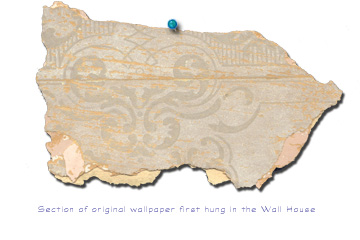

The Wall House was constructed in 1898 for Thomas R. Wall, an Oshkosh lumberman and banker. Like the Oviatt House, it was designed by architect William Waters who combined late Queen Anne and Colonial Revival styles to create the large home. The integration of these two styles resulted in a two-and-a-half story home with clap board siding, a tall multi-angle roofline, and projecting bay and oriel windows.
.


In 1932, Marion and Morgan left the Wall House and rented it to John Bartlett, Jr. and his wife, who happened to both be former neighbors and residents of other historic homes on this tour. Bartlett grew up across the street in the Albee House and his wife, Katherine Pollock, grew up next door at the Pollock House, where the couple was married on Christmas Day, 1926. By moving into the Wall House, they remained close to their parents, who still occupied their childhood homes.
When John and Katherine Bartlett moved to a farm in 1940, Marion Wall sold the home to Dr. Frederick Caudle, who rented out the home during WWII as his military training duties took him to various locations. He took up residence in the home after his return in 1946. After losing his wife in 1949, Caudle married another faculty member from the University, Dr. Jean Gogolewski, in 1955. Over the course of their tenure, the Caudles hosted many University events, including meetings for the Greek societies, and also allowed the music department to use the second floor of the house. They ran a boarding house in their home for several years and participated in the annual homecoming house decoration contest.

The University acquired the Wall House (then known as the Caudle House) in 1965. Initially the journalism department used the house for offices and the University’s yearbook (Quiver) staff. In January 1972, the Wall House became the Multicultural Education Center, replacing the Inter-Cultural Center which was located in a smaller property. Its mission was to cement better relations among minority students and the administration, University, and the community at large. When it opened, the MEC served 154 African Americans, Hispanics, and Native Americans. The Wall House was listed on the National Register of Historic Places in the United States in 1984. By the 1990s the Wall House was deteriorating, and the University planned to demolish it due to “termite infestation and bad drinking water”. A reversal of those plans came with the chancellorship of Dr. Richard Wells. Because of the efforts of the Wall House Restoration Committee, led by Barbara Sniffen, the University has begun to restore the Wall House and make it compliant with the Americans with Disabilities Act codes.
